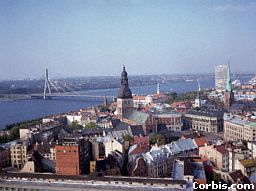| Group | Baltic (with Old Prussian, Lithuanian etc.), East Baltic (with Lithuanian, Semigalian and Selonian) |
| Geography | Latvia |
| History | Historically there were three groups of dialects which formed the language: Central Latvian, the basis of the literature language, Livonian Latvian influenced greatly by Livonian and Curonian languages in the west, and High Latvian or Latgalian in the east, with a lot of Slavic elements in it. The first text in Latvian was written in 1585, but as Latvia gained its independence first only in 1918, the language was shaped only in the 20th century. |
| Phonetics | Different from Lithuanian, Latvian has its stress always on the first syllable, due to Finnish influence. Stops are often palatalized before i, e - for example, Lithuanian kelias equals to Latvian cels [tsels] 'way'. In long syllables, the ancient tonal stress is preserved. |
| Nominal Morphology | Latvian in general is more progressive than Lithuanian. The noun lost the dual number and the neuter gender, the instrumental case coincided with accusative in the singular and with dative in the plural. The definite and indefinite forms of adjectives (called pronominal and general in Lithuanian) are still in use. |
| Verbal Morphology | The same as in Lithuanian, the 3rd person never differs in number: ir means both 'he is' and 'they are'. There are three tenses, both flective and complex constructions are used. Peculiar features include the descriptive and the obligatory moods. |
| Lexicon | The basic vocabulary is originally Baltic. However, there are numerous loanwords, mainly from Finnish (puika 'boy'), German (stunda 'hour') and Russian (robez' 'border'). |
| Writing | At first the Gothic Latin script, then the common Latin alphabet with diacritics |
| Close Contacts | Finnish (Livonian) dialects, later Low German, Swedish, Polish, Russian |
| Sample | .
. |
| Picture |  |
| More info |